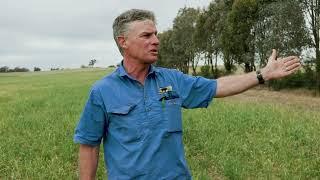
The Riverina Drought Resilient Soils and Landscapes Project - Native Shelterbelts
About the project
The Riverina Drought Resilient Soils and Landscapes project aims to support producers in adopting drought resilient practices and enhance their landscape and soil monitoring capabilities. The Riverina Drought Resilient Soils and Landscapes project (the Riverina Project) is led by Riverina Local Land Services. It is supporting 15 producers to adopt one of three well-established management practices that enhance agricultural productivity and profitability during or after droughts while safeguarding natural resources. The producers are guided in their practice implementation with support from Riverina LLS, and will have opportunities to learn through field days and webinars provided by the project partners, and an online discussion group. By combining observations, simple field assessments, soil lab tests, and peer learning, the producers will enhance their ability to monitor changes resulting from their chosen management practice.
Native shelterbelts
Woody vegetation strips carefully integrated between paddocks offer a range of benefits that contribute to both farm productivity and the conservation of natural assets. Shelterbelts serve as vital tools for livestock protection, erosion mitigation, and wind-speed reduction across pastures and crops. Their significance extends beyond these functional aspects, as native shelterbelts play a crucial role in supporting diverse wildlife populations and aiding natural pest control on the farm. To find out more, visit project partner Sustainable Farms’ website.
Project partners
This project is led by Riverina Local Land Services, in conjunction with Sustainable Farms ANU, and Soils for Life. This project has received funding from the Future Drought Fund.
Produced by the Grow Love Project
The Riverina Drought Resilient Soils and Landscapes project aims to support producers in adopting drought resilient practices and enhance their landscape and soil monitoring capabilities. The Riverina Drought Resilient Soils and Landscapes project (the Riverina Project) is led by Riverina Local Land Services. It is supporting 15 producers to adopt one of three well-established management practices that enhance agricultural productivity and profitability during or after droughts while safeguarding natural resources. The producers are guided in their practice implementation with support from Riverina LLS, and will have opportunities to learn through field days and webinars provided by the project partners, and an online discussion group. By combining observations, simple field assessments, soil lab tests, and peer learning, the producers will enhance their ability to monitor changes resulting from their chosen management practice.
Native shelterbelts
Woody vegetation strips carefully integrated between paddocks offer a range of benefits that contribute to both farm productivity and the conservation of natural assets. Shelterbelts serve as vital tools for livestock protection, erosion mitigation, and wind-speed reduction across pastures and crops. Their significance extends beyond these functional aspects, as native shelterbelts play a crucial role in supporting diverse wildlife populations and aiding natural pest control on the farm. To find out more, visit project partner Sustainable Farms’ website.
Project partners
This project is led by Riverina Local Land Services, in conjunction with Sustainable Farms ANU, and Soils for Life. This project has received funding from the Future Drought Fund.
Produced by the Grow Love Project
Комментарии:
I Love You So Much! (Animation Meme)
Nutshell Animations
Das ist Berlin #5
Das ist Berlin Bitch
Azim Premji Scholarship l Get Scholarship of 30000/Year
Gaurav tips & info
Azim premji scholarship apply
Star Science
The INSANE Wealth of India’s Richest Families
Beyond The Billionaires
TFI interviews Rishi Tiwari who was expelled from Azim Premji University for his views
The Frustrated Indian
Biography of Azim Premji In Hindi- अजीम प्रेमजी की जीवनी | Life Story | Wipro Success Story
Biography in Hindi - एक जीवनी


























